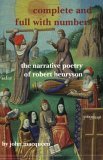

These 15th century Scots clothing & dress accessory terms come from The morall fabillis of Esope the Phrygian ca. 1450 (the Bassandyne ms.), The testament of Cresseid ca. 1480 (the Charteris ms.), and other works by Robert Henryson.
- Ane bag off silk, all at his belt he weir (Esope 1352)
- Sum half on lyfe, he stoppit in his bag. (Esope 1873)
- Quhen thow art put in luceferis bag (Esope 1928)
- Zone reid bonat scho raucht him with hir heill. (Esope 1054)
- His bonat round, and off the auld fassoun. (Esope 1346)
- On hekillit wyis vntill his girdill doun. (Esope 1345)
- Ane bag off silk, all at his belt he weir (Esope 1352)
- Hir belt suld be of benignitie / Abowt hir middill meit ("The Garmont of Gud Ladeis")
- His chymmeris wes off chambelate purpour broun (Esope 1350) [This comes into question as another ms. reads the word in question as chemeis.]
- Hir gluvis of gud govirnance / To hyd hir fynyearis fair. ("The Garmont of Gud Ladeis")
- His gowne wes off ane claith als quhyte as milk (Esope 1349)
- Now gounis gay, now brats laid in pres. (Esope 2938) [Note that brats here means 'rags.']
- Doctour in phisick cled in ane skarlot goun (Cresseid 250)
- Thy gay garmentis with mony gudely goun (Cresseid 422)
- Hir gown suld be of gudlines, / Weill ribband with renowne, / Purfillit with plesour in ilk place, / Furrit with fyne fassoun. ("The Garmont of Gud Ladeis")
- Hir hat suld be of fair having ("The Garmont of Gud Ladeis")
- And hesperous put of his cluddie hude (Esope 616)
- On kneis fell, with hude in to his nek. (Esope 664)
- Mak ze sic feir, ryse vp put on zour hude? (Esope 668)
- His hude he drew far doun attoure his ene (Esope 959)
- Cum furth lowrie lurkand vnder thy hude (Esope 987)
- His hude off scarlet, bordowrit weill with silk (Esope 1351)
- His hudeCresseid 244-245)
- Off he honour suld be hir hud, / Upoun hir heid to weir, / Garneist with govirnance so gud, / Na demyng suld hir deir. ("The Garmont of Gud Ladeis")
- Within ane hude he hes ane dowbill face ("Against Hasty Credence")
- Hir hois of honestie, I ges, / I suld for hir provyd. ("The Garmont of Gud Ladeis")
- Hir kirtill suld be of clene constance, / Lasit with lesum lufe, / The mailyeis of continwance, / For nevir to remufe. ("The Garmont of Gud Ladeis")
- Hir mantill of humilitie / To tholl bayth wind and weit. ("The Garmont of Gud Ladeis")
(While patelet may be etymologically related to the later English word partlet, it seems likelier that it is related to the Old French word that both have in common, in terms of derivatives -- patelete -- meaning a strip or band of cloth. Since Henryson indicates that the patelet is "of gud pansing" -- pansing being a Scots word for thinking or pondering, related to the French word penser, 'to think' -- it seems more likely that the patelet is worn on the head, and not on the torso as what we commonly think of the term partlet. Perhaps it is, indeed, a strip of cloth; or perhaps it is some other piece of headwear, related to the English word pate.)
- Hir patelet of gud pansing ("The Garmont of Gud Ladeis")
- His sark was all bludy [...] Tak ye my sark that is bludy [...] Quhen that scho lukit to the serk [...] Think on the bludy serk. ("The Bludy Serk")
- Hir sark suld be hir body nixt / Of chestetie so quhyt ("The Garmont of Gud Ladeis")
- Ane peure begger with skrip and staif ("The Abbey Walk")
- Hir schone suld be of sickernes / In syne that scho nocht slyd ("The Garmont of Gud Ladeis")
- Hir slevis suld be of esperance / To keip hir fra dispair ("The Garmont of Gud Ladeis")
- And hir tepat of trewth ("The Garmont of Gud Ladeis")
